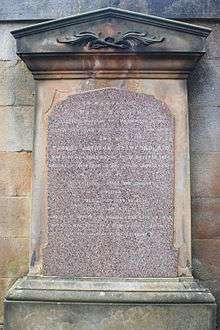Thomas Jackson Crawford


Rev Prof Thomas Jackson Crawford FRSE (1812–1875) was a Scottish minister and Professor of Divinity at Edinburgh University. He served as Moderator of the General Assembly of the Church of Scotland in 1867, the highest level within the Scottish church.
He wrote extensively on religious matters and was very vocal in his adherence to the established Church of Scotland both during and following the Disruption of 1843.
Life
He was born in St Andrews in Fife in 1812 the son of William Crawford, professor of Moral Philosophy at United College in St Andrews University, and his wife, Agnes McDermeit. He was educated at the High School in Edinburgh and then returned to St Andrews to study Divinity at the university, graduating MA in 1831.[1]
In 1834 he became minister in Cults and in 1838 transferred to Glamis to the west. In 1840 he moved to Edinburgh as minister of St Andrews Church. During the Disruption of 1843 within the church, he was a strong advocate and campaigner of remaining within the established Church of Scotland. In 1859, over and above his ministering duties, he was made Professor of Divinity at Edinburgh University and continued in this role until 1875. At this time he was living at 13 Great King Street, a very large Georgian townhouse in Edinburgh’s Second New Town.[2]
In 1861 he was made Chaplain-in-Ordinary to Queen Victoria. In 1867 his eminence led for him being elected Moderator of the General Assembly of the Church of Scotland. He was elected a Fellow of the Royal Society of Edinburgh in 1871, his proposer being John Hutton Balfour.[3]
He died in Genoa in Italy on 11 October 1875.
His body was returned to Edinburgh where he was buried in Dean Cemetery on 12 January 1876 next to his wife, Mary Rankin (1830-1853) who had died young. The grave lies on the north wall of the original cemetery.
Publications
See[4]
- Reasons of Adherence to the Church of Scotland (1843)
- An Argument for Jewish Missionaries (1847)
- Presbyterianism Defended Against the Exclusive Claims of Prelacy (1853)
- Presbytery or Prelacy (1867)
- The Fatherhood of God (1867)
- The Doctrine of Holy Scripture, Respecting the Atonement (1871)
- The Mysteries of Christianity (1874)
Family
He married twice: firstly to Mary Rankine, secondly to Elizabeth Robertson.[5] He had a son, George William Crawford.
Artistic Recognition
His marble bust, by William Brodie is within the University of Edinburgh Art Collection.[6] A very early photographic negative (1843) by Hill & Adamson is held by the Scottish National Portrait Gallery.[7]
References
- ↑ https://www.royalsoced.org.uk/cms/files/fellows/biographical_index/fells_indexp1.pdf
- ↑ Edinburgh and Leith Post Office Directory 1861-2
- ↑ https://www.royalsoced.org.uk/cms/files/fellows/biographical_index/fells_indexp1.pdf
- ↑ Dictionary of National Biography: Thomas Jackson Crawford
- ↑ http://www.geni.com/people/Thomas-Jackson-Crawford-Professor-of-Divinity-Edinburgh/6000000023913852505
- ↑ http://collections.ed.ac.uk/art/record/19517?highlight=*:*
- ↑ http://cdm16490.contentdm.oclc.org/cdm/ref/collection/p15531coll1/id/68